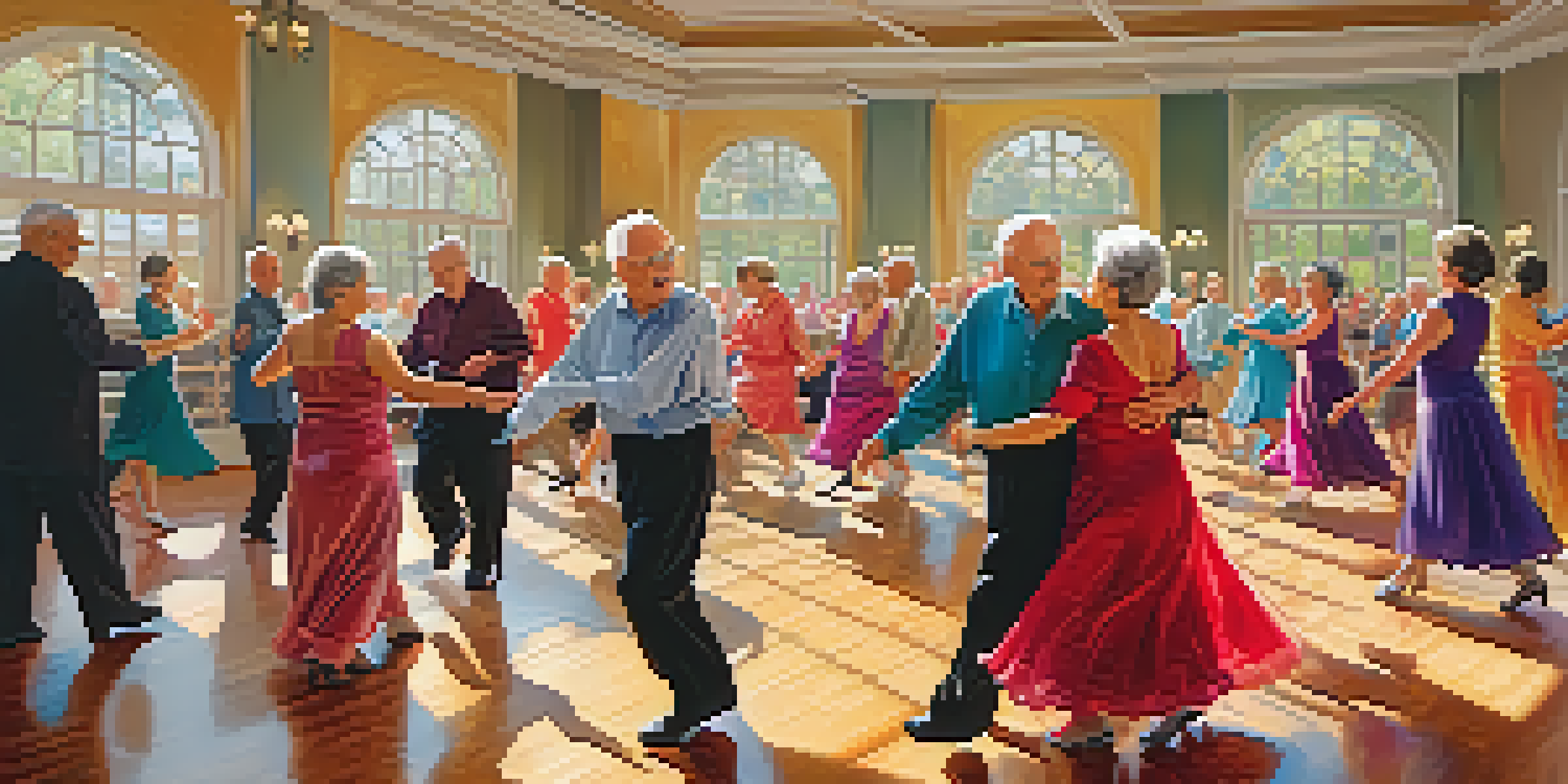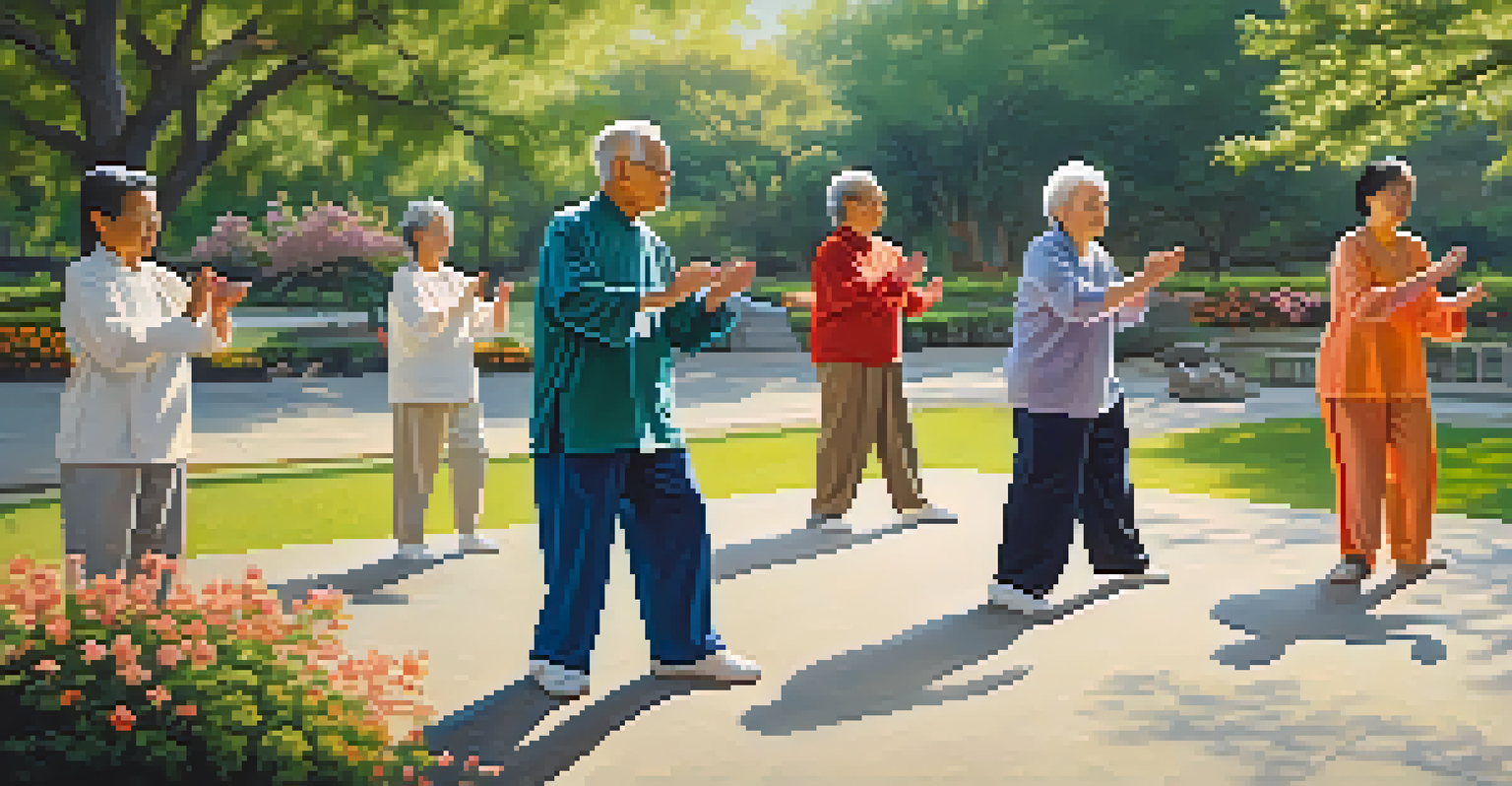The Impact of Dance on Balance and Coordination in Seniors

The Importance of Balance and Coordination for Seniors
As we age, maintaining balance and coordination becomes crucial for preventing falls and injuries. These skills are essential not just for physical stability but also for preserving independence. A simple misstep can lead to serious consequences, making it vital for seniors to engage in activities that challenge their balance.
Dance is the hidden language of the soul.
Good balance and coordination help seniors navigate everyday tasks more confidently, from walking to getting up from a chair. These abilities can also enhance overall physical health, leading to a more active lifestyle. When seniors feel stable, they are more likely to participate in social and community activities.
Moreover, balance and coordination are interconnected with cognitive functions. Engaging in activities that require these skills can stimulate the brain, helping to keep it sharp and agile. This dual benefit makes improving balance and coordination an essential focus for seniors.
How Dance Enhances Physical Stability in Older Adults
Dance is a powerful tool for improving physical stability among seniors. Different styles of dance, whether it's ballroom, line dancing, or even Zumba, involve movements that require coordination, balance, and strength. These activities engage various muscle groups, helping to improve overall body control.

Additionally, dance routines often include dynamic movements that mimic real-life scenarios, preparing seniors for daily activities. For instance, turning, stepping side to side, or shifting weight helps them practice stability in a safe and enjoyable environment. This practice can translate to better performance in everyday tasks.
Dance Boosts Balance for Seniors
Engaging in dance improves seniors' balance and coordination, enhancing their physical stability and confidence in daily activities.
The rhythmic nature of dance also encourages better posture and alignment, which are essential for balance. By focusing on how their bodies move in relation to music, seniors can develop a greater awareness of their physical presence, leading to improved stability over time.
Mental Benefits of Dance for Seniors and Balance
Beyond physical advantages, dance offers significant mental benefits that contribute to better balance. The act of learning dance routines stimulates cognitive functions, enhancing memory and concentration. This mental engagement is vital as it keeps the brain active and responsive.
To keep the body in good health is a duty... otherwise we shall not be able to keep our mind strong and clear.
Furthermore, dance often involves social interaction, which can reduce feelings of isolation and loneliness among seniors. Engaging with others in a dance class not only boosts mood but also encourages collaboration and encouragement, creating a supportive environment for improvement.
As seniors become more confident in their dance skills, they may also experience an increase in self-esteem. This newfound confidence can further motivate them to engage in physical activities, creating a positive feedback loop that enhances both balance and overall well-being.
Types of Dance Beneficial for Seniors' Balance and Coordination
There are several types of dance that can specifically benefit seniors looking to enhance their balance and coordination. For instance, ballroom dancing emphasizes partner work, which can help improve spatial awareness and communication. This style encourages seniors to synchronize their movements with a partner, fostering both physical and social skills.
Line dancing is another excellent option as it offers repetitive movements that help reinforce muscle memory and coordination. The structured nature of line dancing allows seniors to focus on footwork and timing, which are essential for maintaining balance.
Mental Benefits of Dance
Learning dance routines stimulates cognitive functions, promoting memory and concentration while fostering social connections among seniors.
Lastly, gentle forms of dance like Tai Chi combine fluid movements with balance training, making it ideal for those who may have limited mobility. Tai Chi promotes slow, controlled motions that enhance stability, making it accessible for seniors at various fitness levels.
Creating a Safe Dance Environment for Seniors
Safety is paramount when it comes to dance for seniors. Creating a safe environment involves ensuring the dance space is free of obstacles and hazards. Adequate flooring, such as hardwood or dance mats, can prevent slips and falls while allowing for smooth movement.
It's also essential to have proper footwear that provides support and grip. Encouraging seniors to wear shoes designed for dancing can help them maintain balance and prevent injuries. Additionally, appropriate clothing that allows for freedom of movement will enhance their overall experience.
Lastly, having qualified instructors who understand the unique needs of seniors can make a significant difference. An experienced teacher can tailor classes to accommodate various skill levels and offer modifications, ensuring safety while still providing engaging dance experiences.
Incorporating Dance into Senior Wellness Programs
Incorporating dance into senior wellness programs can have transformative effects on participants. Many community centers and retirement homes are recognizing the value of dance, offering classes as part of their health initiatives. These programs not only promote physical fitness but also foster social connections among seniors.
Dance classes can be designed to accommodate varying abilities, ensuring inclusivity for all participants. This approach allows seniors to engage at their own pace, making it a fun and enjoyable way to stay active. The sense of camaraderie that develops in these classes can also enhance motivation.
Safe Dance Environments Matter
Creating a safe and supportive dance environment is crucial for seniors to enjoy the physical and mental benefits of dance.
Moreover, regular participation in dance can lead to measurable improvements in balance and coordination over time. By tracking progress and celebrating achievements, seniors are more likely to stay committed to their wellness journey, making dance an invaluable asset in their lives.
Real-Life Success Stories of Seniors and Dance
Many seniors have experienced profound changes in their lives through dance. For example, a 70-year-old woman named Margaret found joy in a local ballroom dancing class. Initially hesitant, she discovered that not only did it improve her balance, but it also helped her make new friends, enriching her social life.
Another inspiring story is of George, an 82-year-old man who took up line dancing after noticing his balance issues. Within months, he reported feeling more stable on his feet, allowing him to engage in more activities with his grandchildren, something he had previously avoided due to fear of falling.

These success stories highlight the positive impact dance can have on the lives of seniors. By sharing experiences, seniors can encourage one another and foster a community that prioritizes health, happiness, and well-being through the joy of dance.